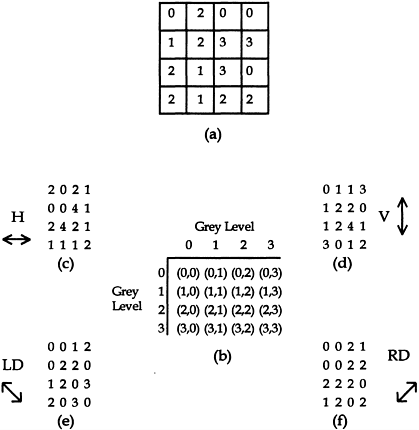129.
| [Cover] [Contents] [Index] |
Page 213

Figure 5.15 (a) A 4×4 image with four grey levels, (b) General form of GLCM with grey levels 0–3. The value contained in cell (i, j) stands for the number of times grey levels i and j occur with a specific direction and distance d. (c-f) present the results with respect to every pixel in image (a), for four directions with angles 0°, 90°, 135°, 45°and d=1.
Figure 5.15c is 24. For the vertical direction, the same rule can be applied, providing a total of 2×(number of rows−1)×(number of columns) nearest neighbour pairs (see Figure 5.15d; the sum of the entries is 24). For the left-diagonal case with d=1, there will be 2×(number of columns −1) pairs for each row except the last. This provides a total of 2× (number of columns−1)×(number of rows−1) left-diagonal nearest neighbour pairs (Figure 5.15e; the sum of entries is computed as 2·(4− 1)·(4−1)=18. For the right-diagonal direction, by symmetry, the number of nearest pairs is the same as the left diagonal (Figure 5.15f; the sum of entries is also 18). After the total number of pairs for each matrix has been obtained, each matrix is normalised by dividing each cell by the total number of pairs.
| [Cover] [Contents] [Index] |
EAN: 2147483647
Pages: 354
- Article 220 Branch-Circuit, Feeder, and Service Calculations
- Article 340 Underground Feeder and Branch-Circuit Cable Type UF
- Article 411: Lighting Systems Operating at 30 Volts or Less
- Annex C. Conduit and Tubing Fill Tables for Conductors and Fixture Wires of the Same Size
- Example No. D4(a) Multifamily Dwelling